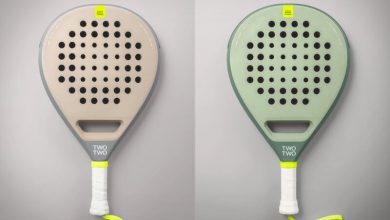Butcher Block Countertops | Julie Blanner
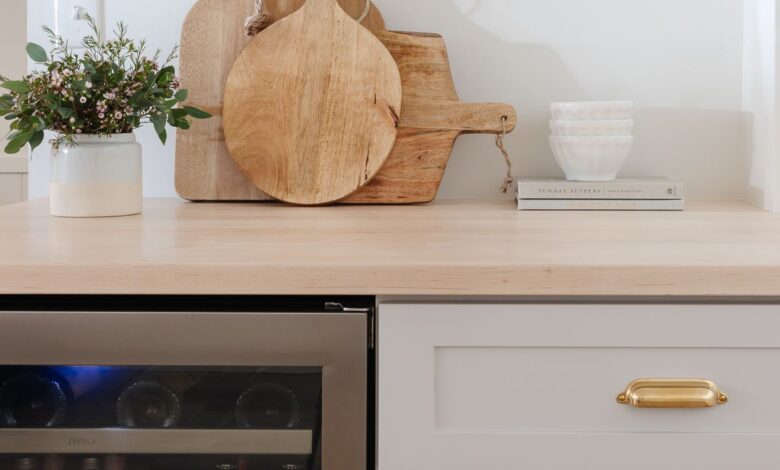
Come see how butcher block countertops can invite warmth and function into your home. With proper care, they can be a beautiful addition to your home for years to come.
Over the years we’ve seen more homeowners turning to wood countertops for their kitchens, islands, and other spaces. Still, some of us have wondered if wood counters are a good idea. Are they safe for food? Will they hold up to water?
The good news is that butcher block countertops can do it all, as long as they are properly sealed and well maintained. And the best part, the rich wood tones they add create so much ambience and classic style.

You know me, I love to make homes feel warm and cozy, and wood counters are a perfect way to do it! In our recently finished basement bar, we decided to add warmth and a soft, light finish with these beautiful butcher block countertops.
Butcher block isn’t just for one design aesthetic, either. Yes, it fits with traditional and farmhouse style. But even modern style can use the warmth of wood and still feel sleek.
If you’d like to read about other types of countertop materials, here’s why I love danby marble, alternatives to marble, and all about quartz countertops. I also talk about other materials, including laminate, solid surface, and concrete in this post about styles of countertop edges.
What Is Butcher Block?
Butcher block, also called butcher’s block, is a wood surface that is made of narrow strips of wood glued together and sanded to create one thick, smooth slab. It is a durable countertop material, as well as an attractive one.
Often when people refer to wood countertops, they’re really talking about butcher block. Many wood countertops are maple, although oak, walnut, cherry, hickory, and teak are other popular options.
You can stain butcher block countertops to any color you like, or you can simply seal them their natural color. If you’ll be staining, remember to sample a small section first, because woods handle stains and colors differently.
Here’s how I tested stain colors on our wood floors.
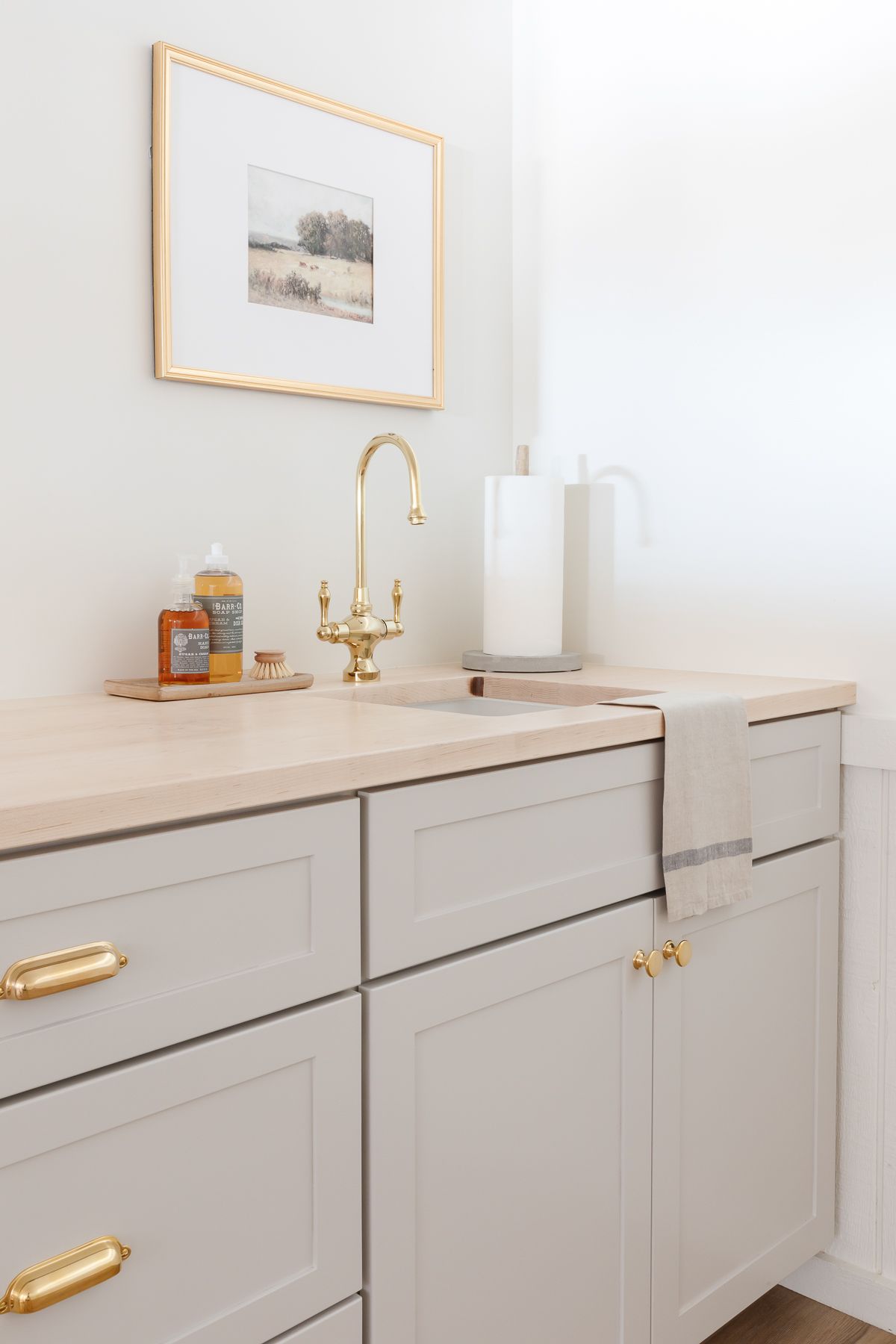
Edge Grain Vs End Grain
Butcher block countertops can be edge grain or end grain. Edge grain is probably what you’re most used to seeing. It is where the lengths of wood are glued together, so you see long, narrow strips of wood.
For end grain butcher block, wood strips are stacked and glued together vertically, so that from the top, you see the end of each strip. It creates the look of a checkerboard.
End grain is more porous, so it requires more frequent oiling and conditioning than edge grain. For this reason, it isn’t the best choice for countertops unless you want to do a lot of maintenance. However, it is an excellent choice for cutting boards, because it easy on blades and will keep your knives sharper for longer.
Where to Use Butcher Block Countertops
Wood countertops would be a beautiful addition to any home, in almost any space. It isn’t recommended for use in bathrooms because it isn’t the most moisture-resistant option. However, there are so many other ways to use butcher block that you won’t want to stop with just one!
- Kitchen Countertops and Kitchen Island – Butcher block would work around the perimeter, but if you’re not ready to redo all of your counters, consider just redoing your island. Your countertops don’t all have to match, and a wood counter on your island makes a great work surface!
- Laundry room – Having an extra surface in a laundry room would be a game changer. While there is water in laundry rooms, they typically don’t have the same level of standing moisture that bathrooms do, so butcher block would be fine with proper care.
- Built-in bookshelves – A wood top would add warmth to the top of base cabinetry as part of built-in bookshelves. They would look gorgeous in any space and would definitely make it look custom.
- Built-in bar – Really, any space you need a countertop – like a built-in bar – would be a great place for butcher block. Especially up against all of the glass bottles, the warm wood tone would provide nice contrast.
- Office desk or craft table – You can buy butcher block counters at stores like Home Depot and Lowes. IKEA sells it along with separate desk legs. You can piece them together to create a piece that fits your space and your needs perfectly.
- Cutting boards – Don’t forget to grab a few cutting boards! Whether you have butcher block countertops or not, it doesn’t hurt to have extra boards on hand to protect your surfaces from knives and hot pans.
Finishing Butcher Block
There are a lot of options for finishing wood countertops, including staining them a color of your choice, sealing them with a durable finish like a polyurethane, choosing a matte or glossy finish, or simply conditioning them with mineral oil.
Finishing with mineral oil requires the most upkeep, since you’ll need to reapply monthly as the wood dries out. However, it’s also the easiest to do, since you don’t need to sand anything down to refinish the surface.
In the end, it comes down to what you want, how you plan to use your surface, and how much work you’re willing to put into maintaining your countertops. Do your research and choose the option that’s best for you and what you need.
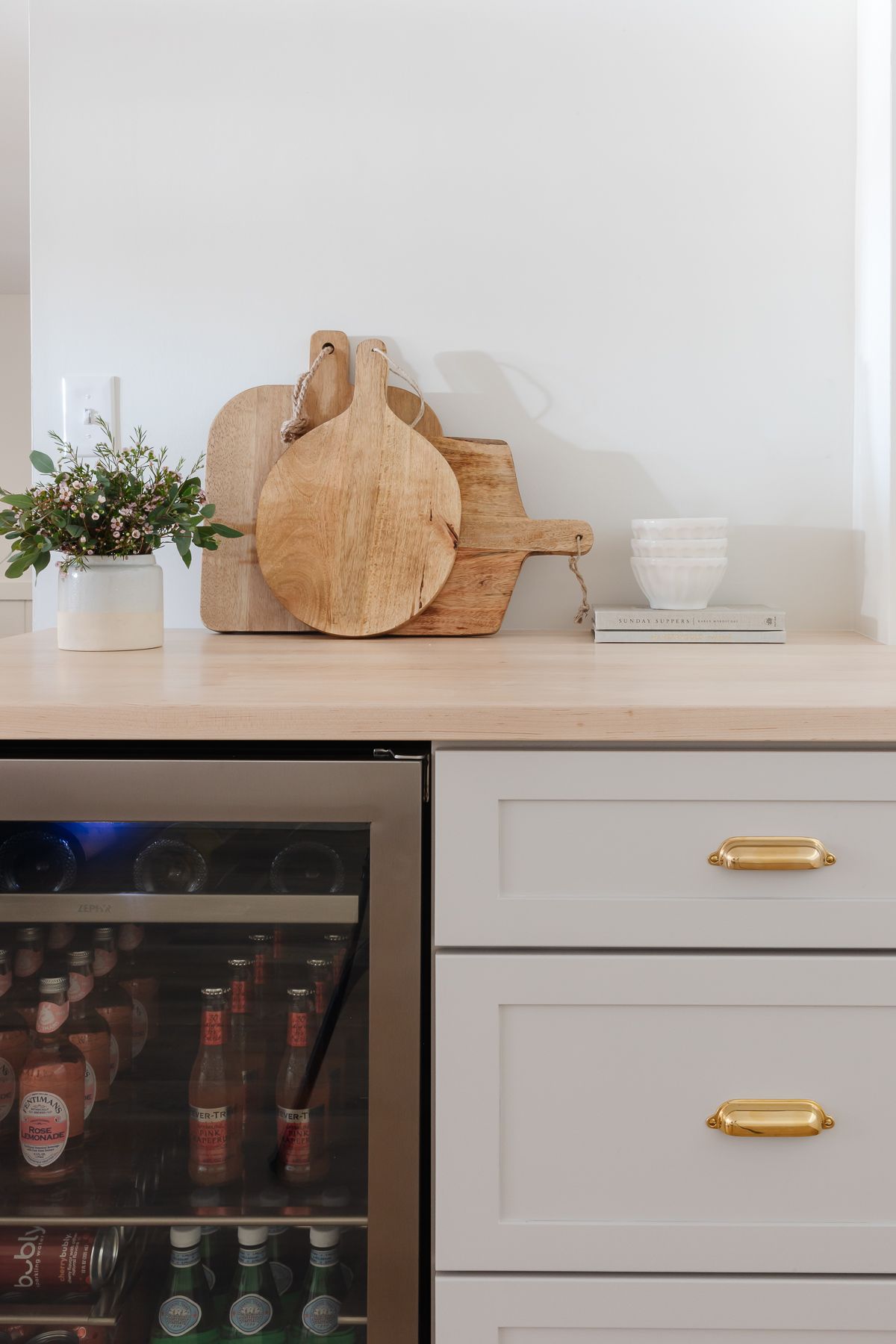
How to Maintain Wood Countertops
Some people shy away from butcher block because of its reputation for being high maintenance. While it’s true that it does require some extra care, there’s nothing to be afraid of. With the proper care, your butcher block countertops can stay beautiful for years to come.
Daily Care
In many ways, butcher block is like granite or marble. It’s not hard to care for, but wood is absorbant and can stain, so it’s important to take care of small mishaps in a timely manner.
You can use a nylon scraper or plastic spatula to lightly scrape the surface free from anything that has dried in place. To wipe the surface, use a cloth dampened with water and mild dishwashing soap.
Remember to never saturate wood countertops with water. If they do become overly wet, make sure to dry them completely as soon as possible.
Removing Stains
Some stains are bound to happen, no matter how vigilant you are. Here are a couple of other tricks you can try.
For fresh stains, try sprinkling them with baking soda. Rub it in then leave it to absorb the stain for a few minutes. Dampen a cloth or sponge with mild dish soap or undiluted vinegar, and use it to scrub at the stain.
Another option is to sprinkle some coarse salt on the stain, then rub it with half a lemon. The stain may disappear completely, but if it doesn’t you can leave it for a couple of days, then try going over it with dish soap or vinegar.
Do not try using this lemon trick on marble countertops, because they’ll etch. Here’s my favorite cleaner for marble countertops.
If all else fails, the nice thing about wood countertops, just like with wood floors, is that you can sand them lightly with a high-grit sandpaper to remove stains. Remember that you’ll have to refinish your counters after sanding.
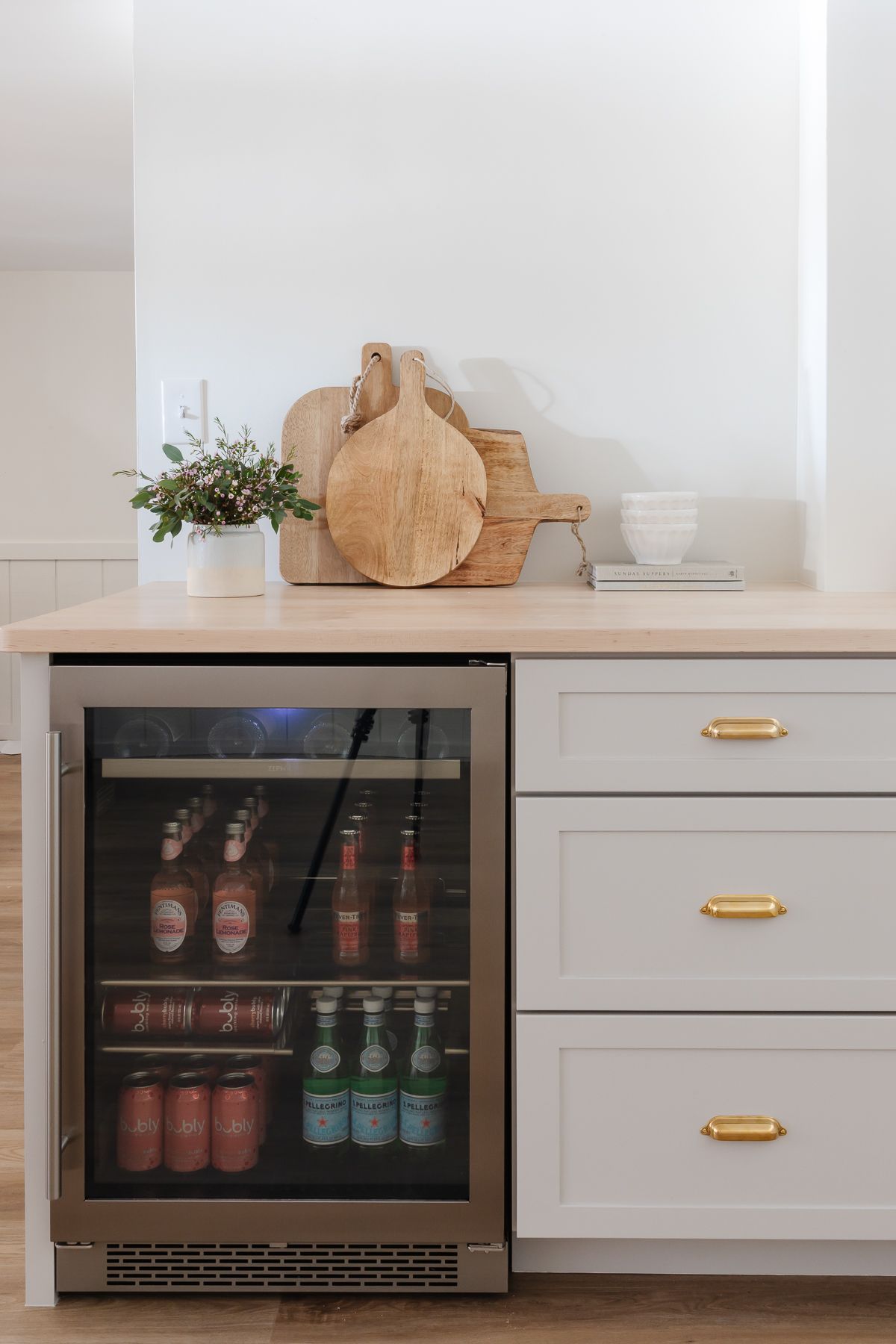
Pros and Cons of Butcher Block Countertops
I get it, countertops can be a big decision. Here are a few things to consider while you’re thinking about wood counters for your home.
Pros
- Adds warmth – The wood tones of butcher block add lovely warm tones to any space, creating a cozy, inviting atmosphere.
- Easy to customize – You can create just the look you have envisioned by choosing the type of wood, color, and finish you want.
- Can be refinished – If you decide to change your look down the road, you can sand down your finish and change your stain color to match your new design.
- Low cost – Compared to other countertop options, butcher block costs less per square foot.
- DIY installation – Experienced DIYers can install wood countertops themselves, using tools they probably have on hand. Pro installation also costs less than other alternatives.
- Easy to clean – Daily cleaning is easy with a damp clean and dish soap. It doesn’t require any fancy or expensive cleaners.
- Long lifespan – With proper care, butcher block counters can last up to 20 years. Laminate countertops typically need to be replaced between 10 and 15 years.
Cons
- Not waterproof – Like any wood product, butcher block is very sensitive to water. They can be installed around a sink if they are sealed very well, re-sealed monthly, and dried right away when they become wet. Wood counters can darken, grow mold, expand and warp if they are exposed to moisture. For this reason, they are not recommended for bathrooms.
- Dent easily – Wood is naturally soft, so it isn’t a surprise that butcher block countertops can become dinged, dented, and scratched. Some people embrace the worn-in look, and if that’s you then go for it! Otherwise, make sure to use a cutting board when using a knife.
- Can burn – The same tip applies when handling hot pots and pans. They can burn and even crack wood counters, so it’s best to use a trivet or hot pad underneath to protect the surface.
- Can expand and contract – Just like wood floors, butcher block can expand in warm temperatures and contract when it’s cool. Its size can change by as much as 1/8-inch from summer to winter. You’ll need to plan ahead by leaving some wiggle room, otherwise your beautiful countertops could warp or even crack.
Looking for more inspiration for organization, decorating and design? Don’t miss my Amazon storefront, which is a highly curated shop always updated with items we truly love and enjoy, including my favorite supplies, accessories and so much more.
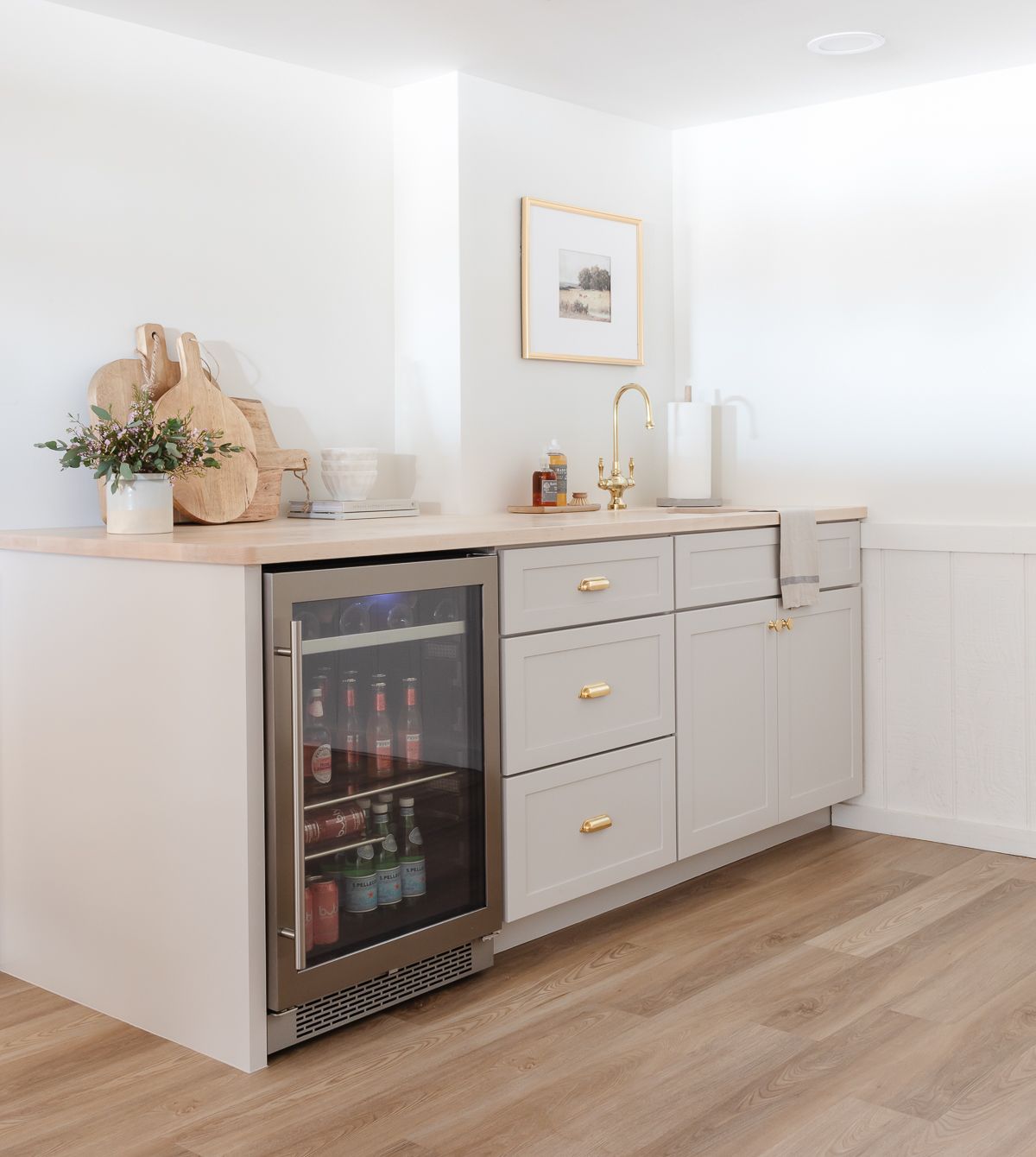
Frequently Asked Questions
No, hot pots and pans can burn wood counters and even cause it to crack. It’s best to use a trivet or hot pad to protect the surface from heat.
Butcher block counters are sanitary once they are properly sealed. If left unsealed, they will absorb germs and bacteria and will be unsafe for food preparation. Properly sealed, they are perfectly safe and sanitary for food prep. They do need to be resealed regularly.
Many kinds of woods are used for butcher block, including maple, oak, cherry, hickory, teak, bamboo, at more. If you’re having custom countertops made, you can likely choose any type of wood you want, as long as you’re willing to pay the cost.
Sources
Our cabinetry and countertops were custom because of the layout of this space, but butcher block countertops are surprisingly affordable! Here are two great options.



